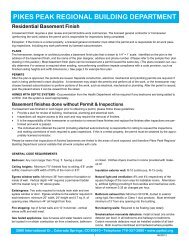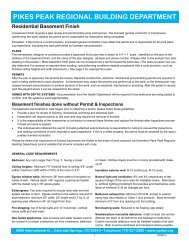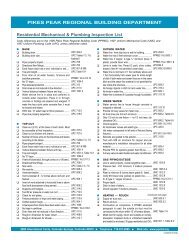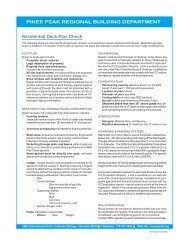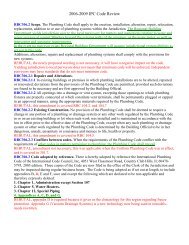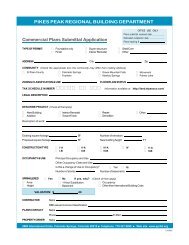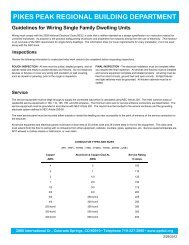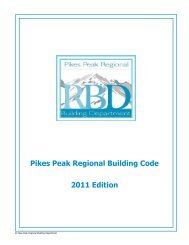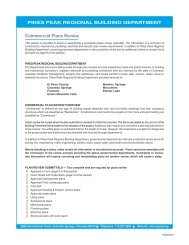SECTION RBC310 - ELEVATOR AND ESCALATOR SAFETY CODE ...
SECTION RBC310 - ELEVATOR AND ESCALATOR SAFETY CODE ...
SECTION RBC310 - ELEVATOR AND ESCALATOR SAFETY CODE ...
- No tags were found...
Create successful ePaper yourself
Turn your PDF publications into a flip-book with our unique Google optimized e-Paper software.
<strong>SECTION</strong> <strong>RBC310</strong> - <strong>ELEVATOR</strong> <strong>AND</strong> <strong>ESCALATOR</strong> <strong>SAFETY</strong> <strong>CODE</strong><strong>RBC310</strong>.1 SHORT TITLE. This section will be knownand cited as the Elevator and Escalator Safety Code.<strong>RBC310</strong>.2 SCOPE. The Elevator and Escalator SafetyCode shall regulate the design, construction, installation,operation, inspection, testing, maintenance, alteration,and repair of new and existing elevators, dumbwaiters,escalators, moving walks, material lifts, and dumbwaiterswith automatic transfer devices.<strong>RBC310</strong>.3 <strong>CODE</strong>S ADOPTED BY REFERENCE. Thereis hereby adopted by reference the Safety Code forElevators and Escalators, ASME A17.1 - 2004 2007,including Table N-1 of Appendix N and all supplementsthereto,; and the Safety Code for Existing Elevators andEscalators, ASME A17.3 - 20022005 and all supplementsthereto, and the ASMEA18.1 2005 Safety Standard forPlatform Lifts and Stairway Chairlifts of the AmericanSociety of Mechanical Engineers, United EngineeringCenter, 345 East 47th StreetThree Park Avenue, NewYork, New York, 10016-59907. Three copies of theseCodes are now filed in the office of the Regional BuildingOfficial and may be inspected during regular businesshours. The above Codes are being adopted as if set out atlength.<strong>RBC310</strong>.4 ADDITIONS <strong>AND</strong> MODIFICATIONS. Theadopted Codes are subject to the following additions andmodifications:<strong>RBC310</strong>.4.1 ASME A17.1 -20042007, Section2.7.62.2.5. Machine Rooms and Spaces. Delete“Elevator machine and” from the first sentence and addthe following to the end of the paragraph: “Elevatormachine rooms are permitted to be located in thehoistway or the pit.”A sump pump is not required to beinstalled in the hoistway pit of a Hydraulic Elevator if:(a) The total travel of the elevator is less than 25feet; and<strong>RBC310</strong>.4.1 (b) The hoistway pit is lessthan 67 inches deep.<strong>RBC310</strong>.4.2 ASME A17.1-2004 2007,; Section5.8. Shipboard Elevators. Delete.<strong>RBC310</strong>.4.3 ASME A17.1 -20042007;, Section5.9. Mine Elevators. Delete.<strong>RBC310</strong>.4.4 ASME A17.1-2004 2007;, Section5.10. Elevators Used for Construction. Delete.<strong>RBC310</strong>.4.5 ASME A17.1-2004; Section8.10.1.1.3. Delete.<strong>RBC310</strong>.4.6 ASME A17.1-2004; Section 8.11.1.1.Persons Authorized to Make Periodic Inspectionsand Tests. Delete.<strong>RBC310</strong>.4.7 <strong>RBC310</strong>.4.5 ASME A17.1-2004 2007,Section 8.11.1.1.2. Periodic Tests.Delete subsection (a) and replaced with the following:(a) The tests referred to as Category 1 and Category5 in Table N-1, of Appendix N, of ASME A17.1 2007and A18.1 2005, shall be performed by a conveyancecontractor on all existing conveyances at frequenciesno greater than 1 year for Category 1 and 5 years forCategory 5. A conveyance Inspector shall witness theperformance of the following test: Category 1 test for(1) Elevator (2) Platform Lift (3) Personnel Hoist and(4) Dumbwaiter at least every 5 years..Delete subsection (b) and replace with the following:(b) The owner or the owners authorized agent shallhave all of the tests required by Sections 8.11.2,8.11.3, 8.11.4, and 8.11.5 conducted by a licensedelevator contractor. A written report document shallbe provided to the Building Department within thirty(30) calendar days with the results of such tests.Exception: Escalators and Moving Walks shall havethe Category 1 Periodic Test as per Appendix N,Table N-1, witnessed by the Building Department orits authorized agent.<strong>RBC310</strong>.4.8 <strong>RBC310</strong>.4.6 ASME A17.1-2004 2007,Section 8.11.1.3. Periodic Inspection and TestFrequency.The frequency of periodic inspections and tests shallbe in accordance with Appendix N, Table N-1.<strong>RBC310</strong>.4.7 ASME A17.1-2004 2007, Section8.11.3.36.5.15. Periodic Test Requirements:Category 3. Delete.<strong>RBC310</strong>.4.9 <strong>RBC310</strong>.4.8 ASME A17.1 2007,Section 8.11.5.8. Delete.<strong>RBC310</strong>.4.9 ASME A17.1 2007, Section 8.11.5.13.Delete.<strong>RBC310</strong>.4.10 ASME A17.1 – 20042007, AppendixN Table N-1. Delete the following items from thiseTable:8.11.5.2. Private Residence Elevators.8.11.5.8. Shipboard Elevators.8.11.5.13. Elevators Used for Construction.<strong>RBC310</strong>.4.11 ASME A17.3 – 20022005, Section1.2. Application of Code: Add the followingexceptions after the second paragraph:Exceptions:(1) All conveyances prior to July 1, 2008, areexempt from complying with ASME A17.3 2005,unless the following conditions exist:(a) Substantial Alteration of a conveyance; or(b) An elevator presents a Material Risk. A riskto public safety as determined by theAuthority Having Jurisdiction.(2) Material Risk related to Firefighters’ Service isnot present except if any of the followingconditions exist:
(a) The elevator complies with ASME A17.12007, rules 211.1 and 211.3; or(b) The elevator travels less than 75 feetabove or below the emergency personnelaccess; or(c) The building is equipped with anautomatic sprinkling system according to theNational Fire Protection Association 13. Anyelevator that does not meet any of theconditions listed above must comply with theFirefighters’ Service requirements as describedin the currently adopted version of ASMEA17.1 2007, by January 1, 2015.(3) Door Restrictors.(a) Door Restrictors shall be installed andoperational by January 1, 2012, on allelevators installed on or after January 1, 1990,and before January 1, 2008;(b) Door Restrictors shall be installed andoperational prior to the next issuance of theCertificate of Operation on all elevatorsinstalled on or after January 1, 2008;(c) Upon review of additional information, theAuthority Having Jurisdiction may determinewhether Door Restrictors shall b required onany elevator installed prior to January 1, 1990.(4) A Hydraulic Elevator that has a hydrauliccylinder buried in the ground and is not providedwith a safety bulkhead, will be allowed tocontinue operation after January 1, 2012, if theconveyance owner completes one of thefollowing actions in conformance with ASMEA17.3 2005:(a) The hydraulic cylinder shall be providedwith a safety bulkhead in accordance withASME A17.1 2007, Section 4.3.3; or(b) The elevator shall be provided with carsafeties conforming to ASME A17.1 2007,Section 3.17.1, and guide rails, guide railsupports, and fastenings conforming to ASMEA17.1 2007, Section 3.23.1; or(c) The elevator shall be provided with aplunger gripper that shall grip the plungerwhen the applicable maximum governortripping speed is achieved per ASME A17.12007, Section 3.17.3.2<strong>RBC310</strong>.4.11 .2.2. Access to Machine Rooms andMachinery Spaces. Delete and replace with thefollowing:a. General Requirements. A permanent,safe, and convenient means of access to elevatormachine rooms and overhead machinery spaces shall beprovided for authorized persons.b. Access Across Roofs. Where passageover roofs is necessary to reach the means of access tomachine rooms or machinery spaces, the following shallbe provided:(1) A stairway with a swing door and platform atthe top level, conforming to the requirements ofSubsection c. below, shall be provided from the top floorof the building to the roof level.(2) Where the passage is over a sloping roofhaving a slope exceeding 3 units vertical in 12 unitshorizontal (25 percent), an unobstructed, permanent,and substantial walkway not less than 24 inches (609.6mm) wide, equipped on at least one side with a handrailnot less than 42 inches (1,066.8 mm) high, shall beprovided from the building exit door at the roof level tothe means of access to the machine room or machineryspaces. Railings shall conform to the requirements ofANSI A12.1c. Requirements for Means of Access.The means of access to machine rooms, machineryspaces and different floor levels in machine rooms, shallconform to the following.(1) A permanent fixed noncombustible ladder orstair shall be provided where the floor of the machineroom or the machinery space above or below the flooror roof from which the means of access leads, or wherethe distance between the machine room floor levels, ismore than 8 inches (203.2 mm).(2) A permanent noncombustible stair shall beprovided where the floor of the machine room or themachinery space above or below the floor or roof fromwhich the means of access leads, or where the distancebetween the machine room floor levels, is 36 inches(914.4 mm) or more. Vertical ladders with handgripsmay be used in lieu of stairs for access from buildingfloors or machine rooms to machinery spaces containingoverhead sheaves, secondary and deflecting sheaves,governors and auxiliary equipment not includingcontrollers and motor generators.(3) Permanent fixed noncombustible ladders shallconform to the requirements of ANSI A14.3.(4) Permanent noncombustible stairs shall have aminimum angle of 60 degrees from the horizontal, andshall be equipped with noncombustible handrails on allopen sides.(5) Permanent non combustible platform or floorshall be provided at the top of the stairs withnoncombustible railings on each open side. The size ofthe platform shall be sufficient to permit the full swing ofthe door plus 24 inches (609.6 mm) from the top of theriser to the swing line of the door. The floor of theplatform shall be at the level or not more than 8 inches(203.2 mm) below the level of the access-door sill.Where the door swings inward, the width of the platformshall be not less than 30 inches (762 mm), and thelength not less than the width of the door.(6) Handrails and railings shall conform to therequirements of ANSI A12.1.d. Access doors and openings.
(1) Access doors to machine rooms and overheadmachinery spaces shall:(a) For machine rooms, be of a minimum width of30 inches (762 mm) and a minimum height of 6 feet(1,828.8 mm); and for other spaces be of a minimumwidth and height of 30 inches (762 mm);(b) Be self-closing and self-locking;(c) Be provided with a spring-type lock arrangedto permit the doors to be opened from the insidewithout a key;(d) Be kept closed and locked.(2) Doors are not required at openings in machineroom floors for access to deflecting and secondarysheavespaces provided the access opening is providedon all four sides with a railing not less than 42 inches(1,066.8 mm) in height, one side of which is arranged toslide or swing to provide access to the ladder or stairsleading to the secondary-sheave space. Trap doors,where provided, shall have railing or guard wings on allopen sides.(3) Access openings in elevator hoistwayenclosures where complete bodily entry is not necessaryfor maintenance and inspection of components shall:(a) Be of adequate size and located to permit therequired maintenance and inspection;(b) Be of maximum width and height of 24 inches(609.6 mm);(c) Be provided with doors which shall be keptclosed and locked.(4) Keys to unlock the access doors to machinerooms shall be kept on the premises in a location readilyaccessible to authorized personnel, but not where theyare accessible to the general public. The keys may bethe same as those used for the pit access door. Keys tothe elevator company’s lock box shall be provided to theBuilding Department.e. Stop Switch in Overhead MachinerySpace in the Hoistway.A stop switch conforming to the requirements of2.26.2.7, shall be provided for each elevator in theoverhead machinery space in the hoistway, adjacent tothe lock jamb side of the door.<strong>RBC310</strong>.4.12 ASME A17.3 - 20022005, Section3.11.31.4. Definitions. Delete and Replace with thefollowing:Add the following definitions:Material Risk. A risk to public safety asdetermined by the Authority Having Jurisdiction.Substantial Alteration. An alteration thatincludes:(a) The change in type of service of an elevator;or(b) The change in type of operation control ormotion control on an elevator; or<strong>RBC310</strong>.4.12 (c) The replacement of acontroller in conjunction with anotheralteration on an electric elevator.3.11.3. Elevators in buildings having floors used forhuman occupancy located more than 75 feet (23 m)above the lowest level of fire department accessshall conform with the requirements of ASME A17.1-1987 Rules 211.3a through 211.8. (As per AppendixC).



